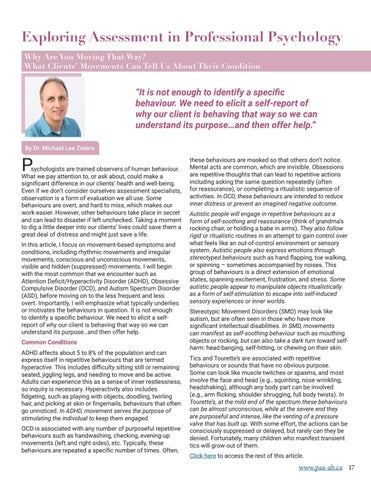Exploring Assessment in Professional Psychology Why Are You Moving That Way? What Clients’ Movements Can Tell Us About Their Condition
“It is not enough to identify a specific behaviour. We need to elicit a self-report of why our client is behaving that way so we can understand its purpose…and then offer help.” By Dr. Michael Lee Zwiers
P
sychologists are trained observers of human behaviour. What we pay attention to, or ask about, could make a significant difference in our clients’ health and well-being. Even if we don’t consider ourselves assessment specialists, observation is a form of evaluation we all use. Some behaviours are overt, and hard to miss, which makes our work easier. However, other behaviours take place in secret and can lead to disaster if left unchecked. Taking a moment to dig a little deeper into our clients’ lives could save them a great deal of distress and might just save a life. In this article, I focus on movement-based symptoms and conditions, including rhythmic movements and irregular movements, conscious and unconscious movements, visible and hidden (suppressed) movements. I will begin with the most common that we encounter such as Attention Deficit/Hyperactivity Disorder (ADHD), Obsessive Compulsive Disorder (OCD), and Autism Spectrum Disorder (ASD), before moving on to the less frequent and less overt. Importantly, I will emphasize what typically underlies or motivates the behaviours in question. It is not enough to identify a specific behaviour. We need to elicit a selfreport of why our client is behaving that way so we can understand its purpose…and then offer help. Common Conditions ADHD affects about 5 to 8% of the population and can express itself in repetitive behaviours that are termed hyperactive. This includes difficulty sitting still or remaining seated, jiggling legs, and needing to move and be active. Adults can experience this as a sense of inner restlessness, so inquiry is necessary. Hyperactivity also includes fidgeting, such as playing with objects, doodling, twirling hair, and picking at skin or fingernails, behaviours that often go unnoticed. In ADHD, movement serves the purpose of stimulating the individual to keep them engaged. OCD is associated with any number of purposeful repetitive behaviours such as handwashing, checking, evening-up movements (left and right sides), etc. Typically, these behaviours are repeated a specific number of times. Often,
these behaviours are masked so that others don’t notice. Mental acts are common, which are invisible. Obsessions are repetitive thoughts that can lead to repetitive actions including asking the same question repeatedly (often for reassurance), or completing a ritualistic sequence of activities. In OCD, these behaviours are intended to reduce inner distress or prevent an imagined negative outcome. Autistic people will engage in repetitive behaviours as a form of self-soothing and reassurance (think of grandma’s rocking chair, or holding a babe in arms). They also follow rigid or ritualistic routines in an attempt to gain control over what feels like an out-of-control environment or sensory system. Autistic people also express emotions through stereotyped behaviours such as hand flapping, toe walking, or spinning – sometimes accompanied by noises. This group of behaviours is a direct extension of emotional states, spanning excitement, frustration, and stress. Some autistic people appear to manipulate objects ritualistically as a form of self-stimulation to escape into self-induced sensory experiences or inner worlds. Stereotypic Movement Disorders (SMD) may look like autism, but are often seen in those who have more significant intellectual disabilities. In SMD, movements can manifest as self-soothing behaviour such as mouthing objects or rocking, but can also take a dark turn toward selfharm: head-banging, self-hitting, or chewing on their skin. Tics and Tourette’s are associated with repetitive behaviours or sounds that have no obvious purpose. Some can look like muscle twitches or spasms, and most involve the face and head (e.g., squinting, nose wrinkling, headshaking), although any body part can be involved (e.g., arm flicking, shoulder shrugging, full body twists). In Tourette’s, at the mild end of the spectrum these behaviours can be almost unconscious, while at the severe end they are purposeful and intense, like the venting of a pressure valve that has built up. With some effort, the actions can be consciously suppressed or delayed, but rarely can they be denied. Fortunately, many children who manifest transient tics will grow out of them. Click here to access the rest of this article.
www.paa-ab.ca 17






